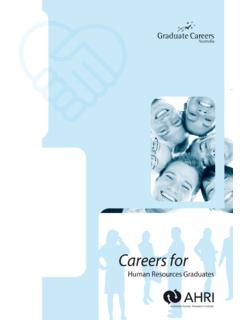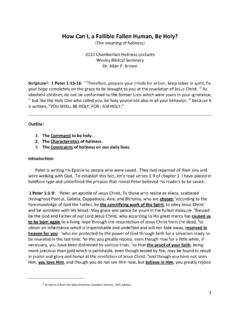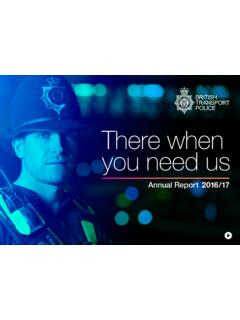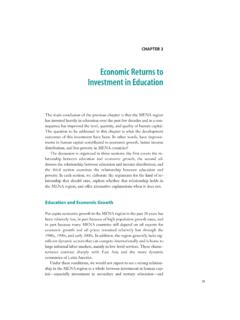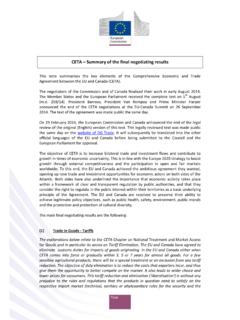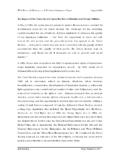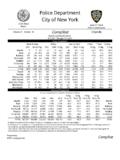Transcription of GradStats - Graduate Careers Australia
1 GradStats EMPLOYMENT AND SALARY OUTCOMES OF RECENT HIGHER EDUCATION GRADUATESDECEMBER 2015 Graduate Careers Australia s (GCA) annual Australian Graduate Survey (AGS) is a study of the activities of new higher education graduates around four months after the completion of their qualifications. In the 2015 AGS, new graduates who completed the requirements for awards in the calendar year 2014 were surveyed regarding their major activities, including labour market activity, further full-time study, or their unavailability for work or gives a summary of preliminary national data concerning the destinations of Australian resident bachelor degree graduates. Overall, per cent of the almost 183,000 Australian resident graduates who were surveyed responded to the AGS. This is very strong for a survey of this nature and provides a reliable set of data.
2 For further information on Graduate employment, Graduate destination statistics and GCA, visit OUTCOMES P. 2 STARTING SALARIES JOB SEARCH STRATEGIES P. 9 Graduate SATISFACTION P. 9 The 2015 AGS saw a slight improvement in the short-term employment prospects of new graduates compared with 2014. In terms of bachelor degree graduates either in or seeking full-time employment (see Table 1a); per cent were in full-time employment within four months of completing their degrees (up from per cent in 2014 but down from per cent in 2013 see Table 1a); per cent had secured a part-time or casual position while continuing to seek full-time employment (down from per cent in 2014, but up from per cent in 2013 see Table 1a); and per cent were not working and still looking for full-time employment at the time of the survey (down from per cent in 2014, but up from per cent in 2013 see Table 1a).
3 However, GCA s Beyond Graduation Survey (BGS) indicates that the middle- and longer-term outlook is very positive. The BGS, which follows up AGS respondents three years after their original survey response, shows that by 2014, the full-time employment figure for 2010 graduates was per cent, an increase of percentage points from per cent. Bachelor degree graduates in the wider Australian workforce (aged 15-74) had (at the time of the survey) an unemployment rate of just per cent compared with an overall rate of per cent and per cent for those with no post-school qualifications (see page 5).{continued}Survey HighlightsDecember 2015 GradStats P. 2 Graduate Careers Australia | results of the 2015 AGS show that, of all new domestic bachelor degree graduates either in or seeking full-time employment, per cent were in full-time employment at the time of the survey, with a further per cent working on a part-time or casual basis while continuing to seek full-time employment.
4 An additional per cent were not working and still looking for full-time employment four months after completing their qualifications (see Table 1a).These figures indicate a slight improvement in the labour market prospects of new bachelor degree graduates compared with the 2014 proportion of graduates continuing in further full-time study in 2015 was per cent, down slightly from 2014 ( per cent, see Table 1). Historically, between one-fifth and one-quarter of respondents elect to continue in further full-time study2 with the figure generally falling when labour market prospects are those graduates available for full-time employment, similar percentages of males and females ( per cent and per cent respectively - see Table 1a) had found a full-time position by the time of the in the general population, part-time employment is an important employment option for some new graduates.
5 In 2015, per cent of respondents were either in part-time employment or seeking part-time work only ( per cent and per cent respectively see Table 1). These are the highest proportions of bachelor graduates in the part-time labour market (and for those not available for full-time employment) seen in the past decade3. Similarly, Table 1a shows that, of graduates still seeking a full-time position at the time of the survey, around two in every three were working in a part-time position while doing so. Females were notably more likely than males ( per cent and per cent respectively) to be working on a part-time basis while continuing to seek a full-time position. This difference (regularly seen in these figures) is likely to be a reflection of females numerical dominance in fields of education such as teaching and nursing, in which there are greater opportunities for part-time professional employment, and previous Graduate Destinations reports have shown that females are more likely to be in professional part-time employment than the other hand, females were less likely than males ( per cent compared with per cent) to have been unemployed while seeking full-time ( per cent) were more likely than females ( per cent)
6 To have undertaken further full-time study in 2015 after The median annual starting salary for new Australian resident bachelor degree graduates aged less than 25 and in their first full-time employment in Australia was $54,000 in 2015, up from $52,500 in 2014. This was per cent (rounded) of the annual rate of male average weekly earnings ($71,214 at the time of the AGS1), up from per cent in 2014 and per cent in 2013 (see Figure 2). One-fifth of respondents ( per cent, down from per cent in 2014), were undertaking further full-time study (see Table 1). Overall satisfaction with courses as measured by the Course Experience Questionnaire (CEQ) remains at a high level, with per cent of graduates expressing broad satisfaction with their courses. Just over half of the graduates who found full-time employment in 2014 or 2015 learned of their job first through one of three strategies: searching advertisements on the internet ( per cent), talking to family or friends ( per cent) and visiting university or college Careers services ( per cent).
7 Survey highlights{continued}1 Average Weekly Earnings for males are used as a constant for year-to-year analysis of change, and not in a prescriptive manner. This is discussed in the full Graduate Salaries outcomes & further study2, 3, 4 See related discussion in Graduate Destinations reports available from 2015 GradStats P. 3 Graduate Careers Australia | 1: Activities of bachelor degree graduates, by sex, 2013-15 (%)completing their course in the previous year (see Table 1). Table 1a indicates that per cent of those in full-time employment at the time of the survey already had that full-time position early (before 1 May 2014) in their final year of study. As in previous years, males were notably more likely than females to have had their position before 1 May in their final year of study.
8 This figure can vary across institution type, field of education and mode of attendance, with many of these respondents having studied on a part-time basis. Table 1b shows employment figures for various bachelor degree sub-groups. As a general rule, some caution is required when comparing these preliminary summary results as they can be affected by other variables not taken into account here. For example, those who had studied on a mainly part-time basis were notably more likely to have been in full-time employment at the time of the survey ( per cent) than those who had studied mainly full-time ( per cent). However, part-time students often have full-time employment while studying and this gives them an artificial advantage in terms of such unadjusted employment , graduates who studied externally (or by distance education usually part-time students) have notably better full-time employment figures than those who studied internally.
9 The relatively positive employment figures for Aboriginal and/or Torres Strait Islander graduates ( per cent) should be interpreted with a little caution because rather small numbers of respondents are involved; however it is worth noting that most editions of GradStats have observed similar figures over the years. The figures in Table 1b indicate that domestic graduates from a non-English speaking background ( per cent) were taking longer to find full-time employment compared with the total group of graduates, as were those who identified as having a disability ( per cent). Graduates with a combined or double degree had better employment figures ( per cent in full-time employment) than those with a single degree ( per cent). Respondents living in regional areas were also more likely to be in full-time employment than their counterparts in a capital city ( per cent compared with per cent).
10 Table 2 shows the breakdown of bachelor degree graduates available for full-time employment by aggregated field of education, further breaking down the available for full-time employment group in Table 1. Labour market factors that are peculiar to some fields of education can affect the proportions in and seeking employment, especially in a survey such as this, which takes place around four months after the completion of degree requirements. For example, medical graduates, of whom per cent were in full-time employment, always have high proportions in this category due to the requirement that they serve an internship in a public hospital for a period after graduation. Similarly, pharmacy graduates ( per cent in full-time employment) are required to undertake a 12 month period of supervised employment as pharmacists in order to gain professional registration.

